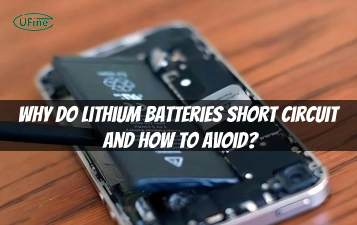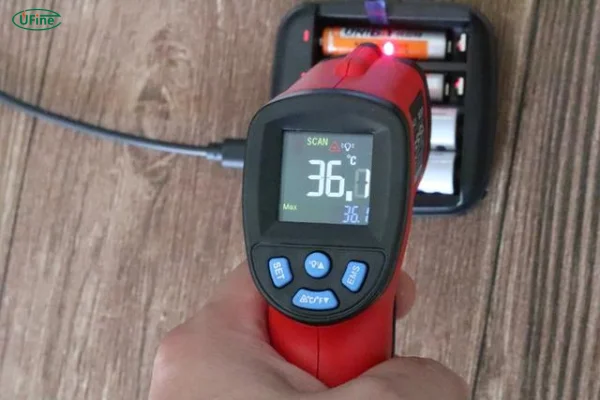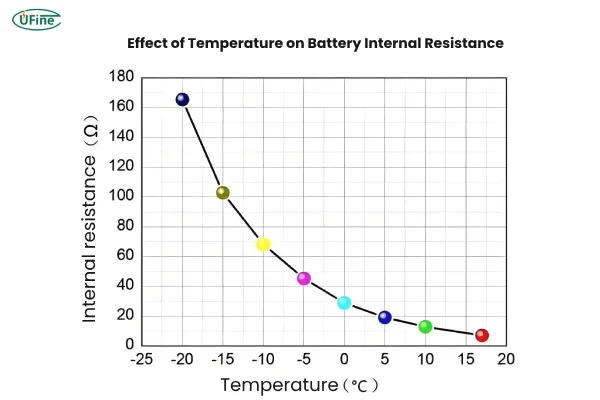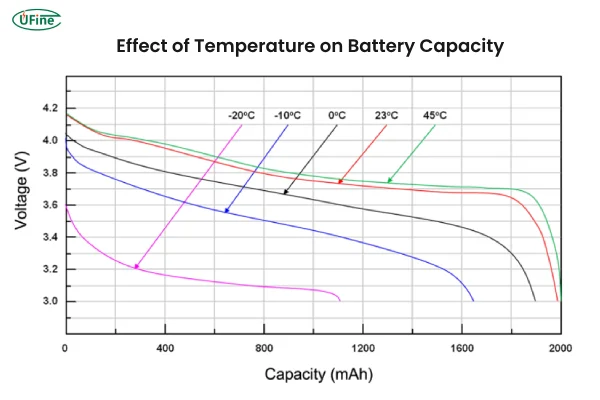
- Part 1. Effects of heat on batteries
- Part 2. Effects of cold on batteries
- Part 3. Ufine Battery's special high-temperature and low-temperature batteries
- Part 4. Temperature’s impact on battery cycle life
- Part 5. Temperature’s effect on battery charging and discharging
- Part 6. Temperature’s impact on battery safety
- Part 7. How to reduce the impact of temperature on batteries?
When we think about battery life, the first things that come to mind are often the device’s energy capacity, how long it takes to charge, or how frequently we need to replace it. But did you know that one of the most critical factors influencing a battery’s performance and longevity is its temperature?
Whether it’s the battery in your phone, laptop, or electric vehicle, temperature plays a pivotal role in determining how efficiently and safely it performs. Extreme temperatures—whether too hot or too cold—can lead to rapid degradation, shortening the battery’s useful life. And in some cases, the effects can be dangerous.
In this article, we will delve into the temperature effects on batteries, examining how both heat and cold impact performance, cycle life, charging, discharging, and safety. By understanding these effects, you can take the necessary steps to protect your battery and keep it functioning at its best for years to come.
Part 1. Effects of heat on batteries
Heat is one of the greatest enemies of any battery. While it may seem like a warm device is a sign of high performance, it’s usually a sign that the battery is working harder than it should. And like any hardworking component, excessive heat can take its toll.
Why Does Heat Harm Batteries?
- Accelerated Chemical Reactions: Heat accelerates the chemical processes inside a battery. This may sound like a good thing at first—faster reactions should mean more power, right? But in fact, it causes increased internal resistance and faster degradation of the materials inside the battery. Over time, this leads to reduced capacity, meaning your battery won’t hold a charge as long as it used to.
- Higher Self-Discharge Rates: Heat also causes batteries to discharge faster, even when not in use. The chemical reactions that power the battery speed up, leading to a phenomenon called self-discharge, which results in a loss of stored energy.
- Thermal Runaway: In the worst-case scenario, excessive heat can lead to thermal runaway, where a battery’s temperature increases uncontrollably, resulting in leakage, fire, or even an explosion. This is especially dangerous in lithium-ion batteries, which are commonly used in consumer electronics and electric vehicles.
So, while it might feel like your device is performing better when it’s warm, it’s crucial to know that excessive heat can significantly impact both performance and safety.
Part 2. Effects of cold on batteries
On the flip side, extreme cold can also wreak havoc on battery performance. Whether you’re dealing with freezing temperatures or just a cooler-than-usual environment, cold temperatures can significantly reduce a battery’s ability to perform as expected.
Why Does Cold Damage Batteries?
- Reduced Capacity: In cold weather, the battery’s electrolytes become more viscous, making it harder for ions to flow within the battery. As a result, the battery delivers a much lower voltage and capacity. You might notice that in winter, your phone, laptop, or car battery drains much quicker than usual, even when not in heavy use.
- Slower Charging: Cold temperatures also affect the charging rate of batteries. Charging a battery when it’s too cold can cause it to charge more slowly or fail to charge altogether. In extreme cases, charging in cold conditions can cause the battery to be damaged permanently, resulting in reduced performance over time.
- Increased Risk of Internal Damage: Charging a battery when it’s too cold may cause lithium metal plating on the anode, which can irreparably damage the battery. For other battery types, such as Nickel-Metal Hydride (NiMH) or Nickel-Cadmium (NiCd), cold temperatures can freeze the electrolyte, leading to permanent battery failure.
Although cold temperatures don’t pose as immediate a safety risk as heat, they still significantly affect battery performance. In fact, many people experience poor performance in their electronic devices during winter months due to the battery’s cold-induced sluggishness.
Part 3. Ufine Battery’s special high-temperature and low-temperature batteries
At Ufine Battery, we understand the critical importance of temperature management when it comes to battery performance and safety. That’s why we offer a range of high-temperature lithium batteries and low-temperature batteries, specially designed to perform optimally under extreme conditions.
Whether you need a battery that can withstand intense heat or one that performs efficiently in freezing cold environments, Ufine Battery has the right solution for you. Additionally, we offer customizable options tailored to meet your specific requirements, ensuring your devices or applications stay powered, no matter the weather.
If you’re looking for reliable temperature-resistant batteries, don’t hesitate to contact us. Our team is here to help you find the perfect battery solution for your needs.
Part 4. Temperature’s impact on battery cycle life
A battery’s cycle life refers to the number of charge and discharge cycles it can go through before its capacity degrades to a point where it’s no longer effective. Temperature plays a huge role in determining how long a battery lasts.
-
Heat Shortens Cycle Life: High temperatures, especially when sustained over long periods, drastically shorten a battery’s cycle life. The chemical degradation that occurs due to heat means that the battery will lose capacity much more quickly, and the total number of charge cycles before replacement is reached will be much lower.
-
Cold Conditions: While cold temperatures may not directly accelerate degradation, they still affect the efficiency of the charging process and can lead to incomplete cycles, where the battery doesn’t charge to its full capacity. This causes more stress on the battery, and over time, it can result in premature failure.
Maintaining a battery in an optimal temperature range is crucial to extending its cycle life. Most manufacturers recommend storing and using batteries at room temperature for maximum longevity.
Part 5. Temperature’s effect on battery charging and discharging
Charging and discharging are key processes that can be deeply affected by temperature.
- Charging: Charging a battery at an improper temperature (either too hot or too cold) can be harmful. Charging in heat can result in overheating and decreased battery life, while cold charging can lead to incomplete charging and internal damage.
- Discharging: When a battery discharges in extreme temperatures, the rate of energy release can be much faster than usual. In hot conditions, a battery will discharge quicker, leading to a shorter runtime for your devices. In cold conditions, the battery’s ability to deliver energy is diminished, and your devices may lose power faster than you expect.
Understanding the right temperature ranges for charging and discharging is essential for maintaining battery performance and ensuring safety. In general, most batteries function best within the 20°C to 25°C (68°F to 77°F) range.
Part 6. Temperature’s impact on battery safety
When it comes to safety, temperature is an even more critical factor. Overheating and freezing can lead to catastrophic consequences, such as fires, explosions, or permanent damage.
-
Overheating: Heat is often the cause of thermal runaway, which is a dangerous and self-perpetuating process that can cause a battery to overheat, catch fire, or even explode. For example, lithium-ion batteries are highly susceptible to thermal runaway if they are exposed to excessive heat.
-
Freezing: Cold temperatures may not result in instant failure, but prolonged exposure to freezing conditions can damage a battery irreparably. In extreme cold, some batteries may even experience liquid electrolyte freezing, which can lead to permanent capacity loss.
Thus, keeping your batteries within safe operating temperatures is paramount for both performance and safety.
Part 7. How to reduce the impact of temperature on batteries?
While you can’t always control the temperature around you, there are several ways to minimize the damage caused by temperature extremes.
-
Store Batteries Properly: When not in use, always store batteries in a cool, dry place that avoids exposure to extreme temperatures. Avoid leaving batteries in cars or areas where temperatures fluctuate.
-
Use Insulated Cases: If you’re using batteries in environments prone to extreme temperatures, consider investing in insulated battery cases or battery blankets. These accessories help maintain a stable temperature for your battery, protecting it from rapid temperature changes.
-
Avoid Charging in Extreme Conditions: Don’t charge your device in excessively hot or cold conditions. If you notice your device becoming uncomfortably hot during charging, stop charging and let it cool down.
-
Monitor Battery Temperature: Many modern devices come equipped with temperature sensors. Regularly monitor your battery’s temperature to avoid overheating. If your device feels too hot, stop using it and allow it to cool.
-
Choose the Right Battery: Some batteries are designed to withstand temperature extremes better than others. For instance, lithium iron phosphate (LiFePO4) batteries tend to be more resilient to temperature fluctuations compared to other lithium-based batteries.
Related Tags:
More Articles

What Is the Lithium Battery Short Circuit?
What is the lithium battery short circuit? To understand a lithium battery short circuit, we first need to understand how the battery works.
What is the Difference Between Silver Zinc Battery vs. Lithium-ion Rechargeable?
Compare silver zinc and lithium-ion rechargeable batteries: energy density, cycle life, safety, cost, and uses in drones, medical devices, EVs, and electronics.
What are Watts and Watt Hours in Battery?
Understand watt vs watt-hour in batteries: key differences, how to calculate capacity, and why they matter. Includes free comparison table.
Best 10 Blood Pressure Monitor Battery Review: Finding the Most Reliable
Are you looking for a reliable Blood Pressure Monitor battery? Here is a complete guide with the top 10 best blood pressure monitor batteries.
Bluetooth Headphone Battery Guide: All You Need to Know
Maximize headphone battery life with expert tips! Learn how to charge, check, troubleshoot, and choose the best bluetooth headphone battery in 2025.





